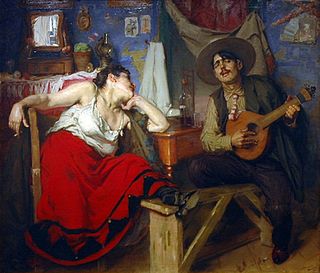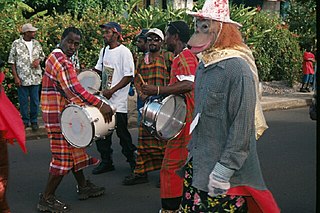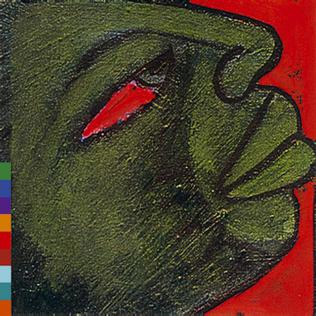The music of Latin America refers to music originating from Latin America, namely the Romance-speaking regions of the Americas south of the United States. Latin American music also incorporate the Indigenous peoples of the Americas. Due to its highly syncretic nature, Latin American music encompasses a wide variety of styles, including influential genres such as cumbia, bachata, bossa nova, merengue, rumba, salsa, samba, son, and tango. During the 20th century, many styles were influenced by the music of the United States giving rise to genres such as Latin pop, rock, jazz, hip hop, and reggaeton.
A roots revival is a trend which includes young performers popularizing the traditional musical styles of their ancestors. Often, roots revivals include an addition of newly composed songs with socially and politically aware lyrics, as well as a general modernization of the folk sound.

Fado is a music genre which can be traced to the 1820s in Lisbon, Portugal, but probably has much earlier origins. Fado historian and scholar Rui Vieira Nery states that "the only reliable information on the history of fado was orally transmitted and goes back to the 1820s and 1830s at best. But even that information was frequently modified within the generational transmission process that made it reach us today."
The native folk music of Mozambique has been highly influenced by Portuguese colonisation and local language forms. The most popular style of modern dance music is marrabenta. Mozambican music also influenced another Lusophone music in Brazil, like maxixe, and mozambique style in Cuba and New York City.

The music of Dominica includes a variety of genres including all the popular genres of the world. Popular music is widespread, with a number of native Dominican performers gaining national fame in imported genres such as calypso, reggae, soca, kompa, zouk and rock and roll. Dominica's own popular music industry has created a form called bouyon, which combines elements from several styles and has achieved a wide fanbase in Dominica. Groups include WCK, Native musicians in various forms, such as reggae, kadans (Ophelia Marie, and calypso, have also become stars at home and abroad.

Portuguese music includes many different styles and genres, as a result of its history. These can be broadly divided into classical music, traditional/folk music and popular music and all of them have produced internationally successful acts, with the country seeing a recent expansion in musical styles, especially in popular music.
The music of Guinea-Bissau is most widely associated with the polyrhythmic genre of gumbe, the country's primary musical export. Tina and tinga are other popular genres.

East Timor's music reflects its history under the control of both Portugal and Indonesia, who have imported music like gamelan and fado. The most widespread form of native folk music was the likurai dance, performed by women to welcome home men after war. They used a small drum and sometimes carried enemy heads in processions through villages; a modern version of the dance is used by women in courtship.
Balkan music is a type of music found in the Balkan region of southeastern Europe. The music is characterised by complex rhythm. Famous bands in Balkan music include Taraf de Haïdouks, Fanfare Ciocărlia, and No Smoking Orchestra.
Ethno jazz, also known as world jazz, is a subgenre of jazz and world music, developed internationally in the 1950s and '60s and broadly characterized by a combination of traditional jazz and non-Western musical elements. Though occasionally equaled to or considered the successor of world music, an independent meaning of ethno jazz emerged around 1990 through the commercial success of ethnic music via globalization, which especially observed a Western focus on Asian musical interpretations. The origin of ethno jazz has widely been credited to saxophonist John Coltrane.
The culture of Mozambique is in large part derived from its history of Bantu, Swahili, and Portuguese rule, and has expanded since independence in 1975. The majority of its inhabitants are black Africans. Its main language is Portuguese. Its median religion is Roman Catholicism, but only about 40% of the inhabitants are Christian. It has a rich history in the areas of arts, cuisine, and entertainment.
Neyma Julio Alfredo is a Mozambican singer. She is known for producing songs of the Mozambican genre, such as Marrabenta and Kizomba.
Humberto Carlos Benfica, known as Wazimbo, is a Mozambican vocalist considered one of the greatest voices of Mozambique and one of the most famous marrabenta singers. Born in Chibuto, in Gaza Province, Mozambique he moved to the capital — Lourenço Marques — where he grew up in the popular neighborhood Mafalala. There he started as a vocal member for the local group "Silverstars" and then "Geiziers". Later, he joined Orchestra Marrabenta Star de Moçambique.
Stewart Sukuma, born Luis Pereira in 1963, is a Mozambican singer. Sukuma's stage name means "rise up" in Xitsonga and "push" in Swahili. He was born in Cuamba, Niassa Province. Coming from a modest family, Sukuma loved music; he moved to the Mozambican capital of Maputo in 1977, learning to play percussion instruments, guitar and piano. Five years later, Sukuma joined a musical group as a vocalist. He received a Ngoma Mozambique award in 1983, and has been described as "Mozambique's most popular male vocalist". Sukuma's songs include "Felizminha", "Xitchuketa Marrabenta", "Sumanga", "Male" and "Why". He sings in Portuguese, English, Swahili, Echwabo and Xitsonga.
Elisa Domingas Jamisse, better known by her stage name Mingas, is a Mozambican singer. Born in the capital city, Maputo in Mozambique Mingas started to sing at a very early age. Her music is a mixture of Afro sounds that gives prominence to the rhythms of the Chope people of southern Mozambique, and she is one of the most famous singers of Marrabenta. Her career is marked with big hits and collaborations with major African singers like Miriam Makeba, Hugh Masekela, Angélique Kidjo, Baba Maal, Yvonne Chaka Chaka, Jimmy Dludlu, Gilberto Gil, among others.

Marrabenta Stories is a 2004 documentary film directed by Karen Boswall. A musical documentary, it covers Marrabenta, the national music of Mozambique.
Fany Pfumo was a Mozambican-born singer who was mainly active in South Africa. He is considered one of the founders and of the prominent artists in the marrabenta style scene. Born to a poor family, he started his career playing an "oil tin guitar" in Maputo's suburbs but later moved to South Africa in search of a better living. In Johannesburg, Pfumo had the opportunity to record with HMV, achieving international fame with songs such as Loko ni kumbuka Jorgina ; this one, in particular, remains one of the best known songs of marrabenta and Mozambican pop music. After achieving international fame in South Africa, Pfumo eventually returned to Mozambique.

Marjurugenta is the debut album by Mozambican marrabenta band Ghorwane, recorded in August 1991 at Real World Studios but not released until September 1993 by Real World Records. The band had built up a reputation in their native country throughout the 1980s for their unique urban dance musical style and politically conscious lyrics, pulling from genres such as marrabenta and xigubu. After being denied visas to play at a European festival in 1987, it soon became possible for the band to play the world music-celebrating WOMAD festival in 1990. While on their trip to the festival, the band were approached by the WOMAD-affiliated Real World Records to record their debut album.





